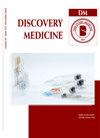Gentiopicroside Ameliorates Cerebrovascular Angiogenesis, Neuronal Injury and Immune Disorder in Rats with Cerebral Ischemia/Reperfusion Injury via VEGF and Phosphorylated Nrf2 Elevation.
IF 2.1
4区 医学
Q3 MEDICINE, RESEARCH & EXPERIMENTAL
引用次数: 0
Abstract
BACKGROUND Cerebral ischemia-reperfusion (CI/R) injury is induction of blood flow restoration after an ischemic stroke. Gentiopicroside (GPC) is the principal active secoiridoid glycoside of Gentiana Manshurica Kitagawa. This research aimed to illuminate the function of GPC and its mechanism in CI/R injury. METHODS After CI/R injury models were constructed, GPC (25, 50 or 100 mg/kg) was then administered by gavage to rats. Rats were grouped into Sham, CI/R, CI/R+25 mg/kg GPC, CI/R+50 mg/kg GPC, and CI/R+100 mg/kg GPC. Neuronal cells were exposed to oxygen-glucose deprivation and reperfusion (OGD/R) injury to establish ischemic-like conditions in vitro, and cells were further treated with 25, 50, or 100 μM GPC. Cells were grouped into control, OGD/R, OGD/R+25 μM GPC, OGD/R+50 μM GPC, and OGD/R+100 μM GPC. GPC's function on rat cerebral injury, angiogenesis, oxidative stress, neuronal injury and immune dysfunction in vivo was estimated using hematoxylin-eosin staining, Western blot, terminal deoxynucleotidyl transferase-mediated dUTP nick-end labeling (TUNEL) staining, commercial kits and enzyme linked-immunosorbent assay. Meanwhile, GPC's mechanism in CI/R injury was examined via Western blot. GPC's function in vitro was estimated via Cell Counting Kit-8 assay, 5-ethynyl-2'-deoxyuridine (EdU) staining, flow cytometry. RESULTS GPC alleviated cerebral injury through decreasing cerebral infarction volume, cerebral indexes, brain water contents (p < 0.05). GPC reduced oxidative stress and boosted cerebral angiogenesis in CI/R rats (p < 0.05). Meanwhile, GPC weakened neuronal cell apoptosis, and decreased neuron-specific enolase and S100beta protein levels in CI/R rats. GPC reduced inflammatory cytokines contents in serum and brain tissues of CI/R rats (p < 0.05). Moreover, GPC increased the viability and proliferation in OGD/R-treated neuronal cells, but decreased cell apoptosis (p < 0.05). Mechanistically, GPC upregulated vascular endothelial growth factor (VEGF) and phosphorylated nuclear factor E2-related factor 2 (p-Nrf2) levels in CI/R rat brain tissues (p < 0.05). CONCLUSIONS GPC reduced cerebrovascular angiogenesis, neuronal injury and immune disorder in CI/R injury through elevating VEGF and p-Nrf2.龙胆苦苷通过VEGF和磷酸化Nrf2升高改善脑缺血/再灌注损伤大鼠的脑血管新生、神经元损伤和免疫功能紊乱
背景:脑缺血再灌注(CI/R)损伤是缺血性脑卒中后血流恢复的诱导。龙胆苦苷(Gentiopicroside, GPC)是北川龙胆的主要活性环烯醚萜苷。本研究旨在阐明GPC在CI/R损伤中的作用及其机制。方法:建立大鼠CI/R损伤模型后,分别给予GPC(25、50、100 mg/kg)灌胃。将大鼠分为Sham、CI/R、CI/R+25 mg/kg GPC、CI/R+50 mg/kg GPC和CI/R+100 mg/kg GPC。采用氧糖剥夺再灌注(OGD/R)法建立体外缺血样条件,并分别给予25、50、100 μM GPC处理。细胞分为对照组、OGD/R组、OGD/R+25 μM GPC组、OGD/R+50 μM GPC组和OGD/R+100 μM GPC组。采用苏木精-伊红染色、Western blot、末端脱氧核苷酸转移酶介导的dUTP镍端标记(TUNEL)染色、商业试剂盒和酶联免疫吸附法,评估GPC在体内大鼠脑损伤、血管生成、氧化应激、神经元损伤和免疫功能障碍中的作用。同时,通过Western blot检测GPC在CI/R损伤中的作用机制。通过细胞计数试剂盒-8、5-乙基-2'-脱氧尿苷(EdU)染色、流式细胞术评估GPC的体外功能。结果:GPC通过降低脑梗死体积、脑指标、脑含水量减轻脑损伤(p < 0.05)。GPC降低CI/R大鼠氧化应激,促进脑血管新生(p < 0.05)。同时,GPC可减弱CI/R大鼠神经元细胞凋亡,降低神经元特异性烯醇化酶和s100 β蛋白水平。GPC降低CI/R大鼠血清和脑组织炎症因子含量(p < 0.05)。此外,GPC能提高OGD/ r处理的神经元细胞的活力和增殖能力,但能降低细胞凋亡(p < 0.05)。机制上,GPC上调CI/R大鼠脑组织血管内皮生长因子(VEGF)和磷酸化核因子e2相关因子2 (p- nrf2)水平(p < 0.05)。结论:GPC通过提高VEGF和p-Nrf2水平降低CI/R损伤的脑血管新生、神经元损伤和免疫功能紊乱。
本文章由计算机程序翻译,如有差异,请以英文原文为准。
求助全文
约1分钟内获得全文
求助全文
来源期刊

Discovery medicine
MEDICINE, RESEARCH & EXPERIMENTAL-
CiteScore
5.40
自引率
0.00%
发文量
80
审稿时长
6-12 weeks
期刊介绍:
Discovery Medicine publishes novel, provocative ideas and research findings that challenge conventional notions about disease mechanisms, diagnosis, treatment, or any of the life sciences subjects. It publishes cutting-edge, reliable, and authoritative information in all branches of life sciences but primarily in the following areas: Novel therapies and diagnostics (approved or experimental); innovative ideas, research technologies, and translational research that will give rise to the next generation of new drugs and therapies; breakthrough understanding of mechanism of disease, biology, and physiology; and commercialization of biomedical discoveries pertaining to the development of new drugs, therapies, medical devices, and research technology.
 求助内容:
求助内容: 应助结果提醒方式:
应助结果提醒方式:


